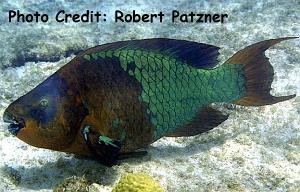
By Bob Goemans


Not Reef Tank Suitable
Not Suitable for Fish-Only Tank
These fishes belong in the Order Perciformes and Suborder Labroidei as members of the Family Scaridae (Parrotfishes) consisting of 2 Subfamilies, 9 genera, and 83 species.
The Family Scaridae does contain a few interesting parrotfishes, yet their diet and physical size makes them very difficult to maintain in the aquarium. They are wrasse-shaped, yet more heavy-bodied. The main difference is the structure of their mouth. Wrasses have individual teeth, but parrotfish teeth are actually fused together, forming a beak. So much the better to feed upon the reef structure itself. In fact, they can be given much credit for producing the sand that settles in lagoons and along beaches. When they bite-off pieces of reef rock, it is ground-up by a set of plate-like teeth in the back of their throat. Any coral polyps and algae on these rock pieces serves as the main course, with the calcium carbonate rock being returned as sand.
Some species of parrotfishes form a mucous cocoon to sleep in at night while tucked-away in some crevice. It is thought these cocoons are a form of protection against nocturnal predators. They are also wide-ranging individuals and don't adapt well to confinement
Since they are herbivores, small plaster of Paris stones that contain seaweed and algae are useful in maintaining them in closed systems.
Overall, only a few in this entire family are to some extent suited for home aquariums, with those being Cetoscarus bicolor (Bicolor Parrotfish), Scarus vetula (Queen Parrotfish) and Sparisoma viride (Spotlight Parrotfish). Even these are far better maintained in public aquariums, as their diet requirements are difficult to adhere to, often leading to their early demise in home aquariums.